Medical training reforms and getting doctors in the regions
Medical training reforms and getting doctors in the regions are on the agenda.

The federal government has taken further steps towards reforming medical workforce training and distribution in the hope Australia will become less reliant on foreign doctors. Some of the changes, however, already have caused controversy, and other issues now on the political agenda are likely to be even more contentious.
Honouring a Coalition election promise, the government has appointed Australia’s first national rural health commissioner, with the former dean of medicine at Flinders University, emeritus professor Paul Worley, taking on the role.
Assistant Health Minister David Gillespie says Worley has a deep understanding of the work of rural doctors and will be charged with developing national rural generalist pathways to recognise the broad nature of such work.
“While developing pathways for rural doctors is a top priority, the commissioner will also consider the needs of the nursing, dental health, pharmacy, indigenous health, mental health, midwifery, occupational therapy, physical therapy and allied health workforce in rural areas,” Gillespie says.
Gillespie — a GP like Worley — also has opened the second round of the Rural Junior Doctor Training Innovation Fund to help respond to the challenge of getting more doctors in regional, rural and remote areas.
“The program is designed so that rural-based junior doctors completing their intern year can gain experience in rural general practice, in addition to their hospital-based rotations,” Gillespie says. “This will improve the pathway for new graduates into challenging and rewarding careers as doctors with the skills rural communities need.”
Health Minister Greg Hunt recently addressed the Royal Australian College of General Practitioners conference. In his speech, Hunt confirmed the college would take over the Australian General Practice Training Program, albeit later than was foreshadowed by Gillespie earlier this year.
“From 2019 to 2021 there’ll be … a program that will progressively transition, and from 2022 onwards the colleges will have full responsibility as they always should have had for the Australian General Practitioner Training program,” Hunt says.
While some details are yet to be finalised, the move has been welcomed by the RACGP and Hunt emphasises “the decision has been made, the direction has been set and the delivery will occur”.
“The college is back in charge of training where it should always have been,” Hunt says.
The announcement has been met with concern from General Practice Registrars Australia, whose president, Melanie Smith, warns that “yet another change will increase angst and despair among registrars and medical students”.
“How the decision is implemented will have a profound effect on the future general practice workforce, and the current uncertainty will impact on the wellbeing and health of registrars,” Smith says, calling for further consultation.
The dispute came ahead of health ministers discussing reforms to mandatory reporting arrangements in an effort to better support doctors, in particular junior doctors, experiencing mental health issues. There was an expectation the Council of Australian Governments Health Council will adopt the so-called WA model.
The RACGP also has been developing a unified pathway for medical practitioners seeking fellowship, and Hunt says the government will consider such an approach and how it will work in regional areas and align with current pathways for overseas-trained doctors.
“We will progressively reduce the number of overseas-trained doctors and increase the number of Australian doctors who are working in the bush,” Hunt told the conference.
“There have been mistakes made historically, where the tap has been turned on or off, what we have to do is provide a glide way.”
The government previously rejected the Department of Health’s call for the immigration pathway for most health practitioners to be closed. The department was concerned locally trained graduates would struggle to get jobs if they had to compete with overseas-trained doctors.
Separately, there has been concern in the professions about the consequences of approving new medical schools, for example the proposed Murray Darling Medical School in Victoria.
Hunt told the conference Worley looked at “taking the existing rural clinical schools and melding them together into a Murray Darling basin network”.
The COAG Health Council, meeting last week, also was due to discuss an independent review of accreditations systems, headed by Michael Woods, formerly of the Productivity Commission.
The review’s proposal that accreditation be further streamlined and brought together under a single cross-professions board has already met with opposition from some health professional groups.
Australian Medical Association president Michael Gannon recently warned that transferring education and training from the boards to a central agency risks “governments fixing workforce problems by reducing standards”.
“For example, you could have a government overnight saying they are going to import 20,000 doctors from West Africa,” Gannon says.
“Or, with the stroke of a pen, governments can try to fix their problems by having nurses do more or other health workers act outside their scope.”


